LOWER BACK PAIN
Mechanical lower back pain / ache may be the result of an injury or overstrain to the discs, spinal joints, muscles, ligaments, tendons or fascial connections through this region.
Sometimes the injury may effect the nerves that run close-by to the aggravated area. This may cause pain to travel to the area the nerve passes. In the lower back this could commonly cause pain to the leg, hip and groin. Other symptoms relating to nerve compression might be pins and needles, tingling and numbness.
Any changes in the bowel or bladder habit relating to lower back pain, should be consulted about as a matter of potential urgency.
Osteopaths take time to assess a patient fully. Running through a case history, postural and mobility assessment. Further specialised tests can be carried out, or referred for if necessary.
Osteopathy is a manual form of treatment. It consists of a wide variety of soft-tissue massage, mobilisation and Osteopathic manipulation techniques. A treatment session is tailor-made to an individual’s needs.
Part of the treatment can be to offer management strategies and advice to better deal with a problem, and to prevent its return. Sometimes this involves prescribing exercises.
The following are some useful lower back exercises. Your Osteopath can direct you as to which exercises may be appropriate to help your type of lower back pain.
Ideally perform these exercises on a mat or towel on the floor, with a pillow under the head for support.
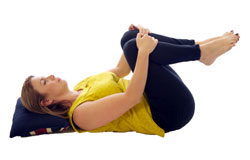
Lower Back Flexion
Lay on your back with your knees bent. Gently hug your knees towards your chest. (Grasp behind the thigh if you have any knee problems) Hold the stretch for a slow count of 10. Relax, repeat 3 to 5 times.
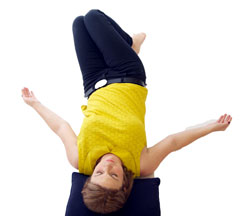
Lower Back Rotation
Lay on your back with your knees bent. Allow both knees to drop down to one side. Only allow the knees to drop as far as you can, whilst maintaining contact on the floor with your shoulder blades. Return your knees back to the start position, and then repeat to the other side. Repeat 5 times on each side.
For a greater stretch through the lower back and hips. Be sure to keep your ankles and knees “glued” together as you perform the exercise. Sometimes placing a small cushion or ball between the knees can help with this.
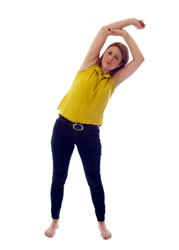
Standing Side-Bending Stretch
From a standing position. Reach one arm up straight so it rests alongside your ear. Bend side-ways, away from the side of the raised arm. You could add some additional stretch by gently stretching through the raised arm with the opposite hand. At the end of the stretch. Take a deep breath into your lower ribs, and then return to normal. Repeat 3 times on each side.
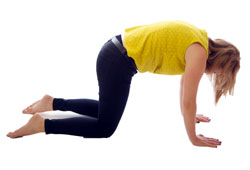
Cat Stretch
Start on your hands and knees, hands under shoulders, and knees under hips. Try and start from a neutral position in the lower back and pelvis (so not too arched through the lower back, but equally not too tucked.) Have a straight neck, with your gaze to the floor.
Begin by tucking your pelvis under, and then continuing the movement up through your lower back, then to your upper back, and then to your neck. So you are arching up like an ‘angry cat’.
Then to return to the start position. Bring your pelvis back to neutral, followed by your lower back, then upper back, and finally your neck.
Repeat 5 times.
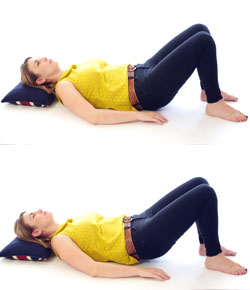
Pelvic Tilt
Lay on your back with your knees bent. Contracting your pelvic floor muscle (the muscle you would use to stop yourself having a wee), and your lower abdominal muscles. Flatten the small of your back into the surface you’re laying on. Hold for a slow count of 2, and repeat 10 times.
